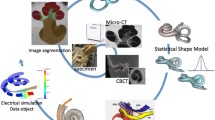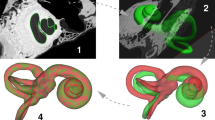Abstract
We present a practical and systematic method to reconstruct accurate physical models of the guinea pig ear (n = 1). The method uses a semi-automatic technique to create three-dimensional (3-D) models of the guinea pig cochlea by registration of micro-computed tomography (CT) and histological images. An iterative closest point algorithm was employed to minimize the sum of square errors with respect to the closest histological model and corresponding micro-CT model. This allowed creation of an accurate geometric ear model including external ear canal, tympanic membrane, middle ear cavity, auditory ossicles, and the cochlea. The characteristic cross-sectional areas of scala tympani, scala vestibuli, and scala media were measured. The length, thickness, and apex width of the guinea pig’s basilar membrane were compared to the data found in literature. Some shape parameters were also compared among different species. The results confirmed that the geometric model created by this method was accurate. This method provides an effective way to visualize the 3-D structure and the detailed information about ear geometry required for finite element and multibody dynamic analysis.





Similar content being viewed by others
References
Besl, P. J., and N. D. McKay. A method for registration of 3-D shapes. IEEE. Trans. Pat. Anal. Mach. Intel. 14(2):239–256, 1992.
Blanz, V., and T. Vetter. A morphable model for the synthesis of 3D faces. In: Proceedings of SIGGRAPH ‘99, New York, NY: Addison-Wesley Publishing Co., pp. 187–194, 1999.
Donahue, D., and R. Gussen. Rapid parlodion embedding of temporal bones. Arch. Otolaryngol. 83(1):28, 1996.
Dorman, M. F., P. C. Loizou, and D. Rainey. Simulating the effect of cochlear-implant electrode insertion depth on speech understanding. J. Acoust. Soc. Am. 102(5):2993–2996, 1997.
Fernández, C. Dimensions of the cochlea (guinea pig). J. Acoust. Soc. Am. 24(5):519–523, 1952.
Funnell, W. R., and C. Laszlo. Modeling of the cat eardrum as a thin shell using the finite-element method. J. Acoust. Soc. Am. 63(5):1461–1467, 1978.
Friedrich, S., Y. L. Cheng, and B. Saville. Finite element modeling of drug distribution in the vitreous humor of the rabbit eye. Ann. Biomed. Eng. 25(2):303–314, 1997.
Gan, R. Z., B. P. Reeves, and X. Wang. Modeling of sound transmission from ear canal to cochlea. Ann. Biomed. Eng. 35(12):2180–2195, 2007.
Gan, R. Z., Q. Sun, B. Feng, and M. W. Wood. Acoustic-structural coupled finite element analysis for sound transmission in human ear—pressure distributions. Med. Eng. Phys. 28(5):395–404, 2006.
Holdsworth, D. W., M. Drangova, and A. Fenster. A high-resolution XRII-based quantitative volume CT scanner. Med. Phys. 20:449–462, 1993.
Hudde, H., and C. Weistenhöfer. A three-dimensional circuit model of the middle ear. Acta Acust United Acus 83:535–549, 1997.
Ketten, D. R., M. W. Skinner, G. Wang, M. W. Vannier, G. A. Gates, and J. G. Neely. In vivo measures of cochlear length and insertion depth of nucleus cochlear implant electrode arrays. Ann. Otol. Rhinol. Laryngol. 107:1–16, 1998.
Koike, T., H. Wada, and T. Kobayashi. Modeling of the human middle ear using the finite-element method. J. Acoust. Soc. Am. 111(3):1306–1317, 2002.
Kolston, P. J., and J. P. Ashmore. Finite element micromechanical modeling of the cochlea in three dimensions. J. Acoust. Soc. Am. 99(1):455–467, 1996.
Kringlebotn, M. Network model for the human middle ear. Scan. Audiol. 17(2):75–85, 1988.
Lee, C. F., J. H. Chen, Y. F. Chou, L. P. Hsu, P. R. Chen, and T. C. Liu. Optimal graft thickness for different sizes of tympanic membrane perforation in cartilage myringoplasty: a finite element analysis. Laryngoscope 117(4):725–730, 2007.
Lee, C. F., J. H. Chen, Y. F. Chou, and T. C. Liu. The optimal magnetic force for a novel actuator coupled to the tympanic membrane: a finite element analysis. Biomed. Eng. 19(3):171–177, 2007.
Lee, C. F., P. R. Chen, W. J. Lee, Y. F. Chou, J. H. Chen, and T. C. Liu. Computer aided modeling of human mastoid cavity biomechanics using finite element analysis. EURASIP. J. Adv. Sig. Proc., 2010 (in press).
Lee, C. F., L. P. Hsu, P. R. Chen, Y. F. Chou, J. H. Chen, and T. C. Liu. Biomechanical modeling and design optimization of cartilage myringoplasty using finite element analysis. Audiol. Neurotol. 11(6):380–388, 2006.
Lee, S. C., H. K. Kim, I. K. Chun, M. H. Cho, S. Y. Lee, and M. H. Cho. A flat-panel detector based micro-CT system: performance evaluation for small-animal imaging. Phys. Med. Biol. 48(24):4173–4185, 2003.
Lee, C. F., C. H. Shih, J. F. Yu, J. H. Chen, Y. F. Chou, and T. C. Liu. A novel opto-electromagnetic actuator coupled to the tympanic membrane. J. Biomech. 41(16):3515–3518, 2008.
Lee-Tuck, J. P., P. M. Pinsky, C. R. Steele, and S. Puria. Finite element modeling of acousto-mechanical coupling in the cat middle ear. J. Acoust. Soc. Am. 124(1):328–362, 2008.
Lim, D. J. Cochlear anatomy related to cochlear micromechanics: a review. J. Acoust. Soc. Am. 67(5):1686–1695, 1980.
Parthasarathi, A. A., K. Grosh, and A. L. Nuttall. Three-dimensional numerical modeling for global cochlear dynamics. J. Acoust. Soc. Am. 107(1):474–485, 2000.
Paulus, M. J., H. Sari-Sarraf, S. S. Gleason, M. Bobrek, J. S. Hicks, D. K. Johnson, J. K. Behel, L. H. Thompson, and W. C. Allen. A new X-ray computed tomography system for laboratory mouse imaging. IEEE Trans. Nucl. Sci. 46(3):546–558, 1999.
Pitas, I. Digital Image Processing Algorithm. Upper saddle River, NJ: Prentice Hall, 1993.
Plontke, S. K., N. Siedow, R. Wegener, H. P. Zenner, and A. N. Salt. Cochlear pharmacokinetics with local inner ear drug delivery using a three-dimensional finite-element computer model. Audiol. Neurotol. 12(1):37–48, 2007.
Poznyakovskiy, A. A., T. Zahnert, Y. Kalaidzidis, R. Schmidt, B. Fischer, J. Baumgart, and Y. M. Yarin. The creation of geometric three-dimensional models of the inner ear based on micro computer tomography data. Hear Res. 243:95–104, 2008.
Rossi, M., F. Casali, M. Bettuzzi, M. Morigi, D. Romani, S. V. Golovkin, and V. N. Govorum. An experimental micro-CT system for X-ray NDT. Proc. SPIE 4503:338–348, 2001.
Sun, Q., K. H. Chang, K. J. Dormer, Jr., R. K. Dyer, and R. Z. Gan. An advanced computer-aided geometric modeling and fabrication method for human middle ear. Med. Eng. Phys. 24(9):595–606, 2002.
Takagi, A., and I. Sando. Computer-aided three-dimensional reconstruction: a method of measuring temporal bone structure including the length of the cochlea. Ann. Otol. Rhinol. Laryngol. 98:515–522, 1989.
Tian, J., J. Bai, X. P. Yan, S. Bao, Y. Li, W. Liang, and X. Yang. Multimodality molecular imaging. IEEE Eng. Med. Biol. Mag. 27(5):48–57, 2008.
Weissleder, R., and M. J. Pittet. Imaging in the era of molecular oncology. Nature 452(7187):580–589, 2008.
West, C. D. The relationship of the spiral turns of the cochlea and the length of the basilar membrane to the range of audible frequencies in ground dwelling mammals. J. Acoust. Soc. Am. 77:1091–1101, 1985.
Woods, R. E., and R. C. Gonzalez. Digital Image Processing (2nd ed.). Upper Saddle River, NJ: Prentice-Hall, 2002.
Acknowledgments
We appreciate the contribution of the Neurobiology and Cognitive Science Center, National Taiwan University, in providing technical support of the dedicated small animal PET/CT scanner for imaging. This study was supported by grants from the National Science Council to C.F.L. (Grant no. NSC 98-2314-B-303003-MY3) and W.J.L. (Grant no. NSC 97-2314-B-002-150-MY2) and a grant from the Buddhist Tzu Chi General Hospital to C.F.L. (Grant nos. TCRD 9703 and 9704).
Author information
Authors and Affiliations
Corresponding authors
Additional information
Associate Editor Joan Greve oversaw the review of this article.
Rights and permissions
About this article
Cite this article
Lee, CF., Li, GJ., Wan, SY. et al. Registration of Micro-Computed Tomography and Histological Images of the Guinea Pig Cochlea to Construct an Ear Model Using an Iterative Closest Point Algorithm. Ann Biomed Eng 38, 1719–1727 (2010). https://doi.org/10.1007/s10439-010-9961-1
Received:
Accepted:
Published:
Issue Date:
DOI: https://doi.org/10.1007/s10439-010-9961-1




